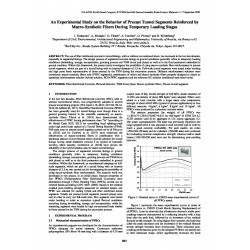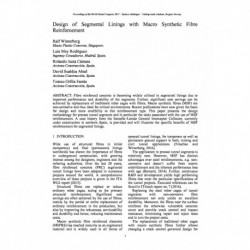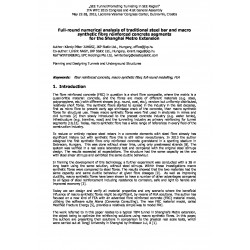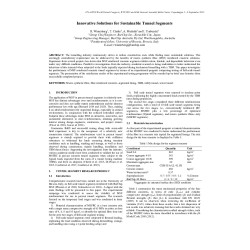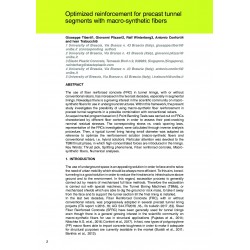No document
Search & filter
Search for a publication
Search & filter
List of products by author: R. Winterberg
-
An Experimental Study on the Behavior of Precast Tunnel Segments Reinforced by Macro-Synthetic Fibers during...
Abstract: The use of fiber reinforced concrete in tunnel linings, with or without conventional rebars, has increased in the two last decades, especially in segmental linings. The design process of segmental concrete linings in ground conditions generally refers to temporary loading conditions (demolding, storage, transportation, grouting process and TBM thrust jack phase) as well as to the final...
0,00 € -
Design of Segmental Linings with Macro Synthetic Fibre Reinforcement
Abstract: Fibre reinforced concrete is becoming widely utilized in segmental linings due to improved performance and durability of the segments. Further, significant cost savings can be achieved by replacement of traditional rebar cages with fibres. Macro synthetic fibres (MSF) are non-corrosive and thus ideal for critical environments. Recent publications have now...
0,00 € -
Design Aspects of Fibre Reinforced Shotcrete Linings based on Experimental Test Results
Abstract: The design of fbre reinforced shotcrete (FRS) linings for tunnels or mines is commonly based on the well-known and widely recognised Q-System or Barton charts. This performance based design approach accesses the results of experimental tests, carried out on panel specimens according to existing standards or guidelines. This is different to the general methodology to access and determine the...
0,00 € -
Full-round numerical analysis of traditional steel bar and macro synthetic fibre reinforced concrete segments for the...
Abstract: The fibre reinforced concrete (FRC) in question is a short fibre composite, where the matrix is a quasi-brittle material: concrete, and the fibres are made of different materials (e.g. steel, polypropylene, etc.) with different shapes (e.g. round, oval, etc.), random but uniformly distributed, relatively short fibres. The synthetic fibers started to spread in the industry in the last decades,...
0,00 € -
Innovative Solutions for Sustainable Tunnel Segments
Abstract: The tunnelling industry continuously strives to reduce construction costs while finding more sustainable solutions. This seemingly contradictory requirement can be addressed by the benefits of macro synthetic fibre (MSF) reinforced concrete solutions. Experience from several projects has shown that MSF reinforced concrete segments exhibit robust, durable, and dependable behaviour even under...
0,00 € -
New Development in Durable Segments for Utility Tunnels
Abstract: A 2km long x 2.74m ID segmental lined tunnel has been constructed for the Blacksnake Creek Stormwater Separation Improvement Project. The project conveys stormwater directly to the Missouri River. This reduces water quantity in the existing sewer during storms and the quantity of combined stormwater and wastewater overflowing to the river. The tunnel is the main element of the Separation...
0,00 € -
Optimized reinforcement for precast tunnel segments with macro-synthetic fibers
Abstract: The use of fiber reinforced concrete (FRC) in tunnel linings, with or without conventional rebars, has increased in the two last decades, especially in segmental linings. Nowadays there is a growing interest in the scientific community on macrosynthetic fibers for use in underground structures. Within this framework, the present study investigates the possibility of using macro-synthetic fiber...
0,00 € -
Solving the Challenges of the Santoña-Laredo General Interceptor Collector
Abstract: The Santoña–Laredo General Interceptor Collector is a 1.5 km subsea tunnel currently under construction in northern Spain and part of the Santoña Marshlands Sanitation Project. It is constructed with a 4.30 m Mixshield TBM, assembled in the tight space of a 12 meter diameter shaft located in an urban area, using fibre reinforced concrete segments. The tunnel excavation passes through two...
0,00 €

